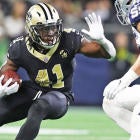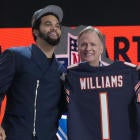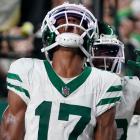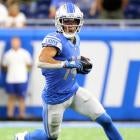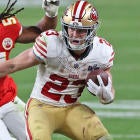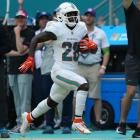We want to set you up for success before you enter the draft room. That's why we're hosting a Fantasy Football Today Telethon on Aug. 22 at noon ET on CBS Sports HQ. The Fantasy Football Today team will be with you for six hours, going over everything you need to know to draft the perfect team. They'll be joined by special guests from around the CBS Sports family, the Fantasy Football community, and even the worlds of sports and entertainment. We will be raising money for St. Jude's Children's Hospital, so make sure you tune at CBSSports.com/live!
Since introducing a new stat called TRAP (Trivial Rush Attempt Percentage), which looks at the Fantasy value of different types of running back touches, I've been jonesing to dive more into what it means and how to utilize it. Let's explore:
Correlation to Fantasy points
Pro Football Focus' Scott Barrett has looked at the correlation between several running back stats and Fantasy points, and found that raw snaps correlate even better than touches as the top two simple opportunity metrics.
Looking at the correlations between various stats and PPR fantasy points at various positions.
— Scott Barrett (@ScottBarrettDFB) May 29, 2018
Note how highly snaps ranks for running backs. pic.twitter.com/DxNO2oiLQS
The only thing that correlates better is total yards, which is of course a chief component of Fantasy points. What's quite interesting is the finding that snaps and touches correlate as high as they do, and even better than other components of Fantasy points like touchdowns. We know that running back is an opportunity-driven position, but this really emphasizes that.
In my previous piece on TRAP, I explained how the stat simply breaks out low-value rush attempts, defined as any rush attempt that occurs outside the green zone (10 yards from the goal line or closer). I reported these findings:
"Over the past five seasons, 75.1% of all running back touches were this type of low-impact rush attempt. Just 42.1% of all running back Fantasy points in the same sample were scored on these plays. Fantasy drafters and analysts alike love 20-carry games, but when they come without receptions and from a player on an offense with limited scoring opportunities, that is an empty workload. It doesn't translate to Fantasy points.
But if we flip those numbers to look at just receptions and green-zone touches, we see that 57.9% of Fantasy points came from a little less than a quarter of total running back touches."
So the first thing I wanted to do was more fully understand how well TRAP correlates to Fantasy scoring. But TRAP wouldn't and doesn't correlate well to raw Fantasy scoring because as a percentage stat it's more about identifying over- and undervalued players. It asks, "on a per-touch basis, which players get a lot of these high-value touches and which have bloated touch counts without many of them?" It would (and does) correlate well to Fantasy points per touch, because then we're putting both on a per-touch basis.
What we can look at is a bit simpler: Raw high-value touches (HVT). As noted above, HVT make up just under 25% of all running back touches, but account for well over half of all running back Fantasy scoring. We are looking at just receptions and green-zone rushes.
So how well do HVT correlate with Fantasy points? It turns out quite well.
Stat | R-squared |
Snaps | 0.694 |
All touches | 0.618 |
HVT | 0.732 |
I'm not able to compare correlation numbers directly with Scott's because the specific data set matters; correlation numbers will be different depending on the running back seasons you're looking at. But above, we're looking at correlation numbers from a data set that includes the 193 running back seasons over the past four years where a RB scored at least 100 PPR points.
On this data set, high-value touches have a higher r-squared than touches. That should probably be expected given all we've done is remove the subset of touches that score the fewest Fantasy points, and that similar to some of the stats in Scott's tweet above, receptions are a component of PPR points.
But it's still quite interesting that by ignoring more than three-quarters of running-back touches we've actually improved the correlation, and it's further notable that HVT also have a higher r-squared than snaps, which raw touches notably don't.
Rethinking the word "committee"
In Fantasy, we shy away from committee backfields. But how do you even define a committee?
Given what we now know about HVT, I would argue a committee -- as it pertains to Fantasy -- shouldn't be defined by how the overall touches are split up, but how the HVT are. That means that if a back is getting plenty of touches but giving up a few key goal-line touches, he may be in more of a Fantasy committee than his touch count indicates. More notably, if an early-down back is only conceding five or six touches a game but those are all coming on passing downs, he's in a committee. He's losing high-value touches, and that's what matters.
But we also have more of a tolerance for some players in committees than others. Alvin Kamara is a top-three pick despite not projecting to be a workhorse. Why is that? Because his offense generates an absurd amount of HVT. Here are the offenses have generated the most HVT for running backs over the past three seasons.
Now, the past shouldn't be expected to perfectly predict the future when looking at a table like this. The Rams shot up the leaderboard after Sean McVay took over in 2017 and the offense improved. In 2016, before drafting Christian McCaffrey, the Panthers had among the fewest HVT over the previous three seasons; after McCaffrey was on the roster, they had a similar climb, and were near the top in 2018.
On the flip side, the 2017 Cardinals had far fewer HVT than the 2016 version of the team, no doubt in large part due to David Johnson's injury. But the offensive scheme in 2018, even after Johnson returned, moved them even further down the list.
Another example: The 2017 Ravens generated plenty of HVT for running backs, and they produced two top-24 PPR backs in Alex Collins and Javorius Allen. But last season, Lamar Jackson's presence meant fewer touches overall for running backs and also a much lower percentage of total touches being high value, because running quarterbacks typically don't throw to their backs as often, instead opting to scramble, a trend we saw late last year in Baltimore.
These are all examples of important considerations when looking at that table and thinking ahead to 2019. But while this might not be the most predictive table, in a descriptive sense it's quite clear the teams nearer to the top of this list have produced big Fantasy running back performances. The 2018 Panthers and 2018 Giants, the teams who had the top two backs in Fantasy last year, both sit in the top 10.
And there are some trends we can try to uncover. One thing this list does well is paint a good picture of how to further highlight how to rethink committee backfields. The Saints and Patriots dominate the top five of this list, and they are two offenses we as Fantasy players are fine investing in despite knowing the touches will be split.
It's the HVT that's the key. If you are looking to draft a running back who may cede high-value touches, his offense better at least be able to generate a lot of them overall. Teams high on this list can support multiple backs; teams near the bottom that may have a committee should be avoided.
Let's wrap this up with a few more team-specific trends and assorted thoughts about the team table:
Much has been made about the battle between Kenyan Drake and Kalen Ballage, but the Dolphins sitting near the bottom of this list for each of the past three seasons is a reminder this isn't a very good offense, and it's unlikely to provide much Fantasy production for running backs unless one of those two takes a significant share of the HVT.
The 2018 Raiders sit surprisingly high on this list, and a huge reason for that was Jalen Richard's receiving role. Jon Gruden has a good history with running backs, and that does speak well for Josh Jacobs, but Jacobs may wind up being the exact type of Fantasy committee back I described above -- one who isn't a traditional committee back but who is ceding HVT when he does give up touches. Richard is a late-round option I'm targeting for potential standalone value plus upside if Jacobs were to miss time.
The Saints sitting atop this list continues to emphasize that Latavius Murray can and will likely beat his ADP. He's a solid mid-round option who also has a ton of upside if Kamara were to miss any time, given the lengthy track record of excellent HVT totals for backs in this offense.
While the 2017 and 2018 Rams were much better than the 2016 version of the team still coached by Jeff Fisher, they came in a lot lower on this list than I anticipated. That drives home how much of Todd Gurley's production the past two seasons has been tied to his huge share of the team's HVT. If he loses some receptions or green-zone touches this year, as expected, his ceiling won't be anywhere near what it used to be.
Similarly, the Steelers rarely had massive HVT totals while Le'Veon Bell was a perennial RB1 candidate. Like Gurley, he dominated his team share. While the changes to offenses like the Panthers and Giants suggest the addition of an elite receiving back might propel the Jets' HVT total up the leaderboard in 2019, they were near the bottom of the list in 2018. For Bell to return value on his ADP, the Jets will need to generate far more HVT for their backs and he'll also need to dominate them in a similar fashion to how he did in Pittsburgh, a two-step I'm not comfortable projecting.
I included the percentage of total touch column specifically to look at HVT totals in relation to massive overall touch counts or a low volume of overall touches. Some of that tracks with team success; Jacksonville's 2017 is an example of a team that had a ridiculous number of overall running back touches buoyed by low-value rush attempts in plus game scripts. In 2018, they logged 133 fewer running back touches overall, but just 10 fewer HVT. Instead, without the clock-draining rush attempts, their rate of HVT was substantially higher. That's a reminder to perhaps not overvalue projected touch count increases for teams you expect to improve, because those increases might not actually mean substantially more HVT.



















